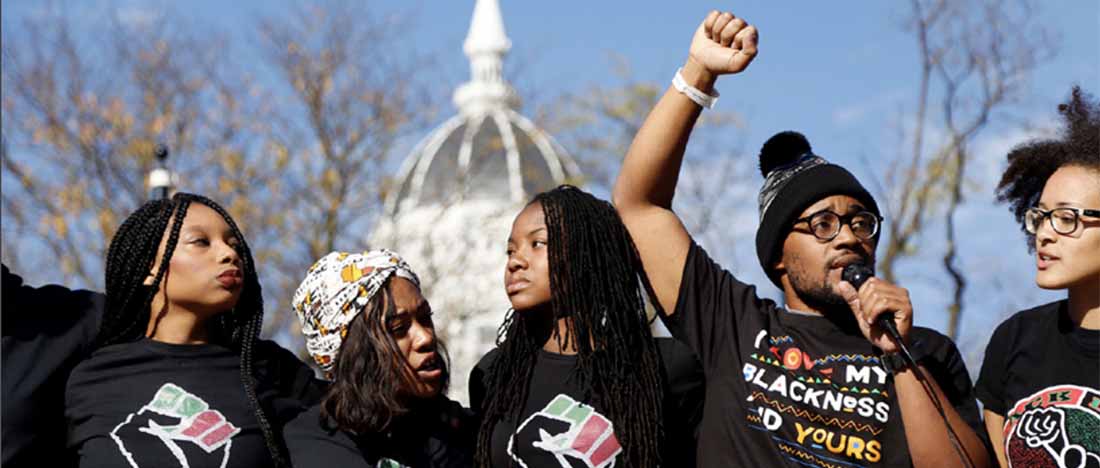
New report explores lessons learned from University of Missouri crisis
Adrianna Kezar, a professor of higher education at the University of Southern California and co-director of the Pullias Center for Higher Education, is the co-author of a new report released today that explores what led to the University of Missouri’s 2015-16 racial crisis and how the institution has since responded, offering recommendations to college and university leaders who strive to create and maintain a positive racial climate on campus.
The report, “Speaking Truth and Acting with Integrity: Confronting Challenges of Campus Racial Climate,” is a collaboration between the University of Missouri’s Office of Diversity, Equity, and Inclusion and ACE’s Center for Policy Research and Strategy (CPRS), spearheaded by ACE’s Vice President for Research Lorelle Espinosa and the University of Missouri’s Vice Chancellor for Inclusion, Diversity, and Equity, Kevin McDonald.
Kezar and and Sharon Fries-Britt, of the University of Maryland, College Park, were the lead authors of the report. In addition, Pullias Center research assistant Marissiko M. Wheaton, along with Elizabeth Kurban and Donté McGuire at University of Maryland, College Park, also contributed to the report.
The report and its findings are informed by 52 interviews conducted with University of Missouri students, staff, faculty, and other community members. The authors also considered previous research on diversity, inclusion, campus racial climate, crisis response, and institutional leadership. They describe longstanding racial tensions and overt incidents on Missouri’s flagship campus and in its surrounding communities, culminating in the now well-known unrest that took place in 2015-16, and resulting in the resignation of the president and chancellor.
The authors chronicle steps taken since this period, including by the university’s current leaders–President of Missouri System Mun Choi, University of Missouri Chancellor Alexander Cartwright, and Chief Diversity, Equity and Inclusion Officer Kevin McDonald–and their commitment to working steadily to provide a diverse and inclusive environment. Using the Missouri case as a jumping off point, the authors introduce a template for other campus leaders facing similar crises and explore best practices for addressing key emotions and trauma that may linger after such incidents.
“This research brings up important insights and actions on the issues of diversity and inclusion, core areas of ACE’s work to improve access, equity, and diversity on our college campuses,” said ACE President Ted Mitchell. “We appreciate the opportunity the University of Missouri has provided for reflection and learning. Such leadership is necessary in today’s higher education environment, not only to learn from the challenges of racism and other forms of discrimination, but also to use that learning to chart a purposeful path forward for the benefit of our communities and society.”
The authors lay out several key takeaways learned from their research and provide a framework for other campuses to build their own capacity to respond to racial crises. These takeaways include:
- Campus context matters. Leaders are encouraged to enhance their own understanding and acknowledgement of the historical legacy of race and racism on campus and in the surrounding community.
- Commitment to diversity and inclusion. Demonstrations of long-term commitment to issues of diversity and inclusion allow for resiliency following a racial crisis.
- Acknowledge and respond to collective trauma. Following a racial crisis, leaders are right to acknowledge racism, hatred, microaggressions, and pain. This response will emphasize to the community that their institution stands up for anti-racist values and, in turn, supports them through the crisis.
- Collective trauma recovery. Leaders should avoid immediately trying to “solve” the problem and instead engage in active listening, speak and connect with the community to recognize hurt and trauma, and build a strategy to move forward.
“Our students, faculty and staff have risen to the occasion and have worked hard to ensure that all members of the university community feel welcomed and encouraged to share their unique perspectives and experiences. As a result, we are stronger and more united as a campus,” University of Missouri Chancellor Alexander N. Cartwright said. “Identifying the best ways to support diversity, equity and inclusion is a challenge at universities across the country. We know we will continue to have difficult conversations as we remain vigilant in our commitment to an environment of respect.”
Since 2015, the University of Missouri has undergone an institutional transformation that includes the hiring of the university’s first chief diversity officer and the creation of a university-wide plan to improve compositional diversity and the learning, living, and working environment. A new required course introduces all new students to the values and culture at the university and underrepresented minority faculty grew by more than 14 percent. In 2018, the freshman class rose by 13 percent from the year prior, showing a return of students from throughout the state, from both urban and rural areas.
“This work required leadership from our students, faculty, staff, supporters and alumni,” University of Missouri System President Mun Choi said. “We invited this review in partnership with ACE because it was important to have an outside view of our progress. We don’t want to take anything for granted and we must continually evaluate our development and commit to doing better. We remain committed to providing leadership that is engaged and transparent in order to become a national model for inclusion and free speech.”
A discussion about the report will be held on Nov. 29 to discuss the report and its findings, and to engage in dialogue with Chancellor Cartwright, Fries-Britt and McDonald. The event, to be held at ACE’s offices in Washington, DC, and streamed online, is open to the public.